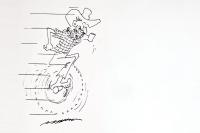Appalachian Women’s Museum finally gets Monteith House
 The Appalachian Women’s Museum finally has a home to call its own.
The Appalachian Women’s Museum finally has a home to call its own.
Dillsboro town council members agreed Monday to lease a section of the historic Monteith farmstead to the organization, whose members have sought a brick and mortar place to honor the feats of Appalachian women.
While the town manages the lion’s share of the 16-acre Monteith tract, whose primary use is a public recreation area, the non-profit organization will assume responsibility for a four-acre section, including a barn and a farmhouse that will serve as the center of the museum.
“To gather, preserve and share the stories of women of southern Appalachia,” said Tim Osment, president of the Appalachian Women’s Museum, reciting the organization’s mission statement.
However, even he acknowledged that to carry out the lofty purpose the organization still has some work to do and is in its beginning stages of planning.
Related Items
“What the actual museum is going to look like is really yet to be determined,” he said.
Years spent in on-again-off-again talks with the town over the Monteith farmstead have put a damper on the organization’s progress. Since the town bought the Monteith property in 2001, the location has been identified as an ideal spot for a women’s museum.
Yet, getting town officials and the organization to come to a consensus and turn over the site to the Appalachian Women’s Museum has been a painstaking process, with town officials citing concerns about accountability and guarantees that the space would be put to proper use.
A previous attempt to strike a deal failed in 2010. The latest round of negotiations began at the first of the year and was finalized this week. Ultimately, the degradation of the property pushed officials over the edge.
“We want to do this, but Dillsboro needs us to do this,” Osment said. “They don’t have the resources to restore it and preserve it.”
This week, council members were able to agree with the museum organizers on a contract that gives the group five years to get the restoration work underway. The cost of the lease is $1 per year, plus the nonprofit group will foot all the expenses of upkeep and repairs. If the first lease goes well, the museum is entitled to take ownership of the farmhouse and extend its lease on the adjacent property for 30 years.
The freshly inked deal was a longtime coming, said Dillsboro Mayor Mike Fitzgerald, who has served with the town throughout years of negotiations with the museum.
“It’ll just be good to get it going,” he said. “We’d just like to have a nice looking house that’s open to the public.”
Striking a deal was just a matter of getting the right players in the right places and arriving at a consensus, he said.
With the museum agreement in place, Fitzgerald sees the potential for more than history exhibits and has asked the museum organizers to provide space for community organizations to host meetings and other events.
But whatever becomes of the house, it should be better than the path of slow decay it is on now, he said.
“It looks more like a haunted house, and it sits there year after year and you wonder why is it just sitting there?” Fitzgerald said. “If you had any house in your town that was an eyesore, you’d want to do something about it.”
However, there’s a lot to be done in those first years of the lease to get the museum in shape, Osment said. He estimates between $300,000 and $400,000 in restoration work needs to be done to the three-story house to make it exhibition worthy.
The property dates back to the early 1900s and is on the National Register of Historic Places. While the inside is supposedly in good condition, the outside structure is showing its age.
“The outside looks very rough,” Osment said. “But when you go inside it’s beautiful.”
The first year, though, Osment said progress may be slow as the organization devotes its efforts primarily to fundraising. Over the years, the Appalachian Women’s Museum has had difficulty soliciting grants and donations without a museum and clear plan of action.
After the deal with Dillsboro was finalized on Monday, Osment expects all that to change.
“We didn’t have a defined mission because we didn’t know if we would get the house or not,” Osment said. “Now we can go to people and say this is the house we want to restore.”
Osment has a history degree from Western Carolina University and has worked with a variety of state and local historical groups. He said the first, and only, Appalachian Women’s Museum will garner support from the historical community. He expects organizers to be able to draw from government grants and resources from universities with women’s studies programs.
Just as important, though, the project has stirred interest in the local community.
“There is no Appalachian women’s museum in the country — that is what is generating a lot of interest outside of Jackson County,” Osment said. “Within Jackson County, they’re saying ‘Oh great, you’re restoring that neat house down there.’”









